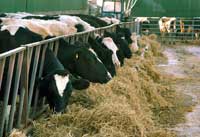Vetwatch: A monthly round-up of vet issues around the UK

Tony Kemmish, St Boniface Vet Clinic, Crediton, Devon
Nine months ago we started offering a comprehensive embryo service and I’ve just visited the first calf born as a result. She isn’t the high genetic merit calf you might associate with embryo work, but the product of a cheap embryo we now routinely put into repeat breeder cows.
Everyone has those cows that come bulling every 21 days, but just won’t get in calf. They are often seen at routine vet visits, having been served more than three times. By implanting an inexpensive embryo seven days after insemination to a natural heat we have seen holding rates in excess of 65%.
Obviously this type of procedure isn’t for every problem cow in the herd and should only be considered after a thorough vet check.
Martha Harris, Larkmead Vet group, Wallingford, Oxfordshire
The recent hot weather has had a number of effects on livestock. As well as having the potential to directly cause heat stress, high temperatures can lower feed intake, reduce expression of bulling behaviour and lower conception rate.
There have been a few cases of necrotising enteritis in suckler calves. It is a disease causing diarrhoea, along with lethargy and loss of condition, with a high mortality rate. The cause has yet to be discovered, but it tends to occur in calves about two months old.
Production is gradually increasing on pig farms following the negative effects on litter size during the winter months. However, the heat is also taking its toll on outdoor units, with heat stress and sunburn.
Mark Spilley, Bishopton Vet Group, Ripon
I am now back into the British vets’ way of life having been fortunate enough to spend nine months in New Zealand. I presented a talk to our clients about my trip and we are now being asked “Why don’t you do our fertility visits at a rate of more than 100 cows an hour?” This is one example of the difference in scale between the vet’s life here and in New Zealand.
I learned a lot from the Kiwi farmers and the attention to detail they put into monitoring and maintaining pasture quality impressed me and is certainly an area we could apply to our systems.
The Kiwi farmers’ awareness of infectious disease was an area that I hopefully helped with in terms of identifying and monitoring herd status and putting in place biosecurity/vaccination strategies when required.
Don McMillan, Minster Vet Group, York
Like Martha in Oxfordshire, we have been experiencing hot weather, and while we do not have dairy herds that are confined indoors, many herds do spend considerable time in buildings. Combine this with the increased heat output from high-yielding herds and production can be severely affected.
In an effort to offset these effects, a number of actions can be taken. Reduce stocking densities in buildings, remove as many internal walls as possible, install fans to increase air speed at cow level, take the sides off buildings if possible and consider the use of sprayers to give a pulse of mist especially in collecting yards where temperatures can be significantly higher. And of course ensure access to plenty of water as requirements can increase by 25 litres per day.
